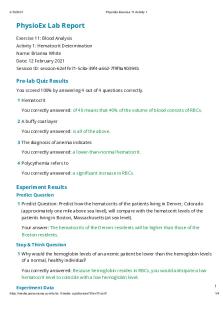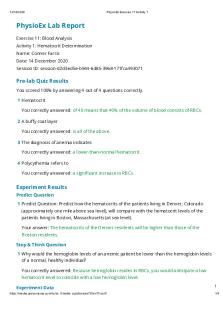Physio Ex Exercise 11 Activity 1 PDF

| Title | Physio Ex Exercise 11 Activity 1 |
|---|---|
| Author | Anonymous User |
| Course | Introductory Biology: Organismal |
| Institution | Community College of Rhode Island |
| Pages | 4 |
| File Size | 70.7 KB |
| File Type | |
| Total Downloads | 100 |
| Total Views | 150 |
Summary
Download Physio Ex Exercise 11 Activity 1 PDF
Description
1/25/2021
PhysioEx Exercise 11 Activity 1
PhysioEx Lab Report Exercise 11: Blood Analysis Activity 1: Hematocrit Determination Name: Lauramarie Pisillini Date: 25 January 2021 Session ID: session-72ed14bd-b83c-106d-07f0-713e4516abb8
Pre-lab Quiz Results You scored 100% by answering 4 out of 4 questions correctly. 1 Hematocrit You correctly answered: of 40 means that 40% of the volume of blood consists of RBCs. 2 A buffy coat layer You correctly answered: is all of the above. 3 The diagnosis of anemia indicates You correctly answered: a lower-than-normal hematocrit. 4 Polycythemia refers to You correctly answered: a significant increase in RBCs.
Experiment Results Predict Question 1 Predict Question: Predict how the hematocrits of the patients living in Denver, Colorado (approximately one mile above sea level), will compare with the hematocrit levels of the patients living in Boston, Massachusetts (at sea level). Your answer: The hematocrits of the Denver residents will be lower than those of the Boston residents. Stop & Think Question 1 Why would the hemoglobin levels of an anemic patient be lower than the hemoglobin levels of a normal, healthy individual? You correctly answered: Because hemoglobin resides in RBCs, you would anticipate a low hematocrit level to coincide with a low hemoglobin level. Experiment Data https://media.pearsoncmg.com/bc/bc_0media_ap/physioex/10/ex11/act1/
i 1/4
1/25/2021
PhysioEx Exercise 11 Activity 1
Blood sample
Height of column of blood
Height of red Height of buffy blood cell coat layer (white blood cells)
Hematocrit
% WBC
1
100 mm
48 mm
1 mm
48
1
2
100 mm
44 mm
1 mm
44
1
3
100 mm
55 mm
1 mm
55
1
4
100 mm
53 mm
1 mm
53
1
5
100 mm
19 mm
0.5 mm
19
0.5
6
100 mm
32 mm
1 mm
32
1
Sample 1: healthy male living in Boston Sample 2: healthy female living in Boston Sample 3: healthy male living in Denver Sample 4: healthy female living in Denver Sample 5: male with aplastic anemia Sample 6: female with iron-deficiency anemia
Post-lab Quiz Results You scored 100% by answering 4 out of 4 questions correctly. 1 Anemia refers to You correctly answered: a lower-than-normal hematocrit. 2 To complete the blood test to measure hematocrit, you must seal the blood-containing capillary tubes on one end with a clay material so that You correctly answered: the blood sample can be centrifuged without having the blood spray out of the tube. 3 Possible causes of polycythemia include You correctly answered: living at high altitudes. 4 You would expect anemia to develop in a person You correctly answered: who has abnormally shaped hemoglobin in their RBCs.
Review Sheet Results i https://media.pearsoncmg.com/bc/bc_0media_ap/physioex/10/ex11/act1/
2/4
1/25/2021
PhysioEx Exercise 11 Activity 1
1 List the hematocrits for the healthy male (sample 1) and female (sample 2) living in Boston (at sea level) and indicate whether they are normal or whether they indicate anemia or polycythemia. Your answer: Healthy Male (sample 1): 48. Hematocrit of 48 for a male is normal, since their normal range is 42-52% Healthy Female (sample 2): 44. Hematocrit of 44 for a female is normal, since their normal range is 37-47%. 2 Describe the difference between the hematocrits for the male and female living in Boston. Why does this difference between the sexes exist? Your answer: The difference between the hematocrits for the male and female living in Boston, were that the male hematocrit was higher than the female. Males have a larger body mass and need more blood cells. 3 List the hematocrits for the healthy male and female living in Denver (approximately one mile above sea level) and indicate whether they are normal or whether they indicate anemia or polycythemia. Your answer: Healthy Male in Denver: 5 Healthy Female in Denver: 53 Both indicate higher than normal values which indicate polycythemia. 4 How did the hematocrit levels of the Denver residents differ from those of the Boston residents? Why? How well did the results compare with your prediction? Your answer: The hematocrit levels of the Denver residents differ from the Boston residents with the Denver residents have the higher hematocrit levels than Boston. Denver is at a higher altitude meaning that the people who live there need to make more bloods cells to carry the adequate amount of oxygen throughout the body. Th results compared to my prediction being the opposite, because I didn't factor in that the higher the altitude the more the body needs more oxygen, meaning that the bloods cells need o be greater. 5 Describe how the kidneys respond to a chronic decrease in oxygen and what effect this has on hematocrit levels. https://media.pearsoncmg.com/bc/bc_0media_ap/physioex/10/ex11/act1/
i 3/4
1/25/2021
PhysioEx Exercise 11 Activity 1
Your answer: the kidneys release erythropoietin which then stimulates erythropoiesis in the red bone marrow. THis causes an increases in hematocrit levels. 6 List the hematocrit for the male with aplastic anemia (sample 5) and indicate whether it is normal or abnormal. Explain your response. Your answer: Male with Aplastic Anemia: 19. This hematocrit is abnormally low because people with aplastic anemia do not produce enough blood bells in the red bone marrow. 7 List the hematocrit for the female with iron-deficiency anemia (sample 6) and indicate whether it is normal or abnormal. Explain your response. Your answer: Female with Iron-deficiency: 32. The level is abnormally low because the blood cells do not have enough iron and the body can not make hemoglobin.
i https://media.pearsoncmg.com/bc/bc_0media_ap/physioex/10/ex11/act1/
4/4...
Similar Free PDFs

Physio Ex Exercise 11 Activity 1
- 4 Pages

Physio Ex Exercise 11 Activity 1
- 4 Pages

Physio Ex Exercise 11 Activity 1
- 4 Pages

Physio Ex Exercise 11 Activity 1
- 4 Pages

Physio Ex Exercise 11 Activity 1
- 4 Pages

Physio Ex Exercise 11 Activity 4
- 4 Pages

Physio Ex Exercise 11 Activity 2
- 5 Pages

Physio Ex Exercise 11 Activity 3
- 3 Pages

Physio Ex Exercise 11 Activity 4
- 4 Pages

Physio Ex Exercise 11 Activity 2
- 3 Pages

Physio Ex Exercise 11 Activity 5
- 3 Pages

Physio Ex Exercise 11 Activity 4
- 6 Pages

Physio Ex Exercise 11 Activity 2
- 3 Pages

Physio Ex Exercise 11 Activity 3
- 3 Pages

Physio Ex Exercise 11 Activity 2
- 3 Pages

Physio Ex Exercise 1 Activity 1
- 4 Pages
Popular Institutions
- Tinajero National High School - Annex
- Politeknik Caltex Riau
- Yokohama City University
- SGT University
- University of Al-Qadisiyah
- Divine Word College of Vigan
- Techniek College Rotterdam
- Universidade de Santiago
- Universiti Teknologi MARA Cawangan Johor Kampus Pasir Gudang
- Poltekkes Kemenkes Yogyakarta
- Baguio City National High School
- Colegio san marcos
- preparatoria uno
- Centro de Bachillerato Tecnológico Industrial y de Servicios No. 107
- Dalian Maritime University
- Quang Trung Secondary School
- Colegio Tecnológico en Informática
- Corporación Regional de Educación Superior
- Grupo CEDVA
- Dar Al Uloom University
- Centro de Estudios Preuniversitarios de la Universidad Nacional de Ingeniería
- 上智大学
- Aakash International School, Nuna Majara
- San Felipe Neri Catholic School
- Kang Chiao International School - New Taipei City
- Misamis Occidental National High School
- Institución Educativa Escuela Normal Juan Ladrilleros
- Kolehiyo ng Pantukan
- Batanes State College
- Instituto Continental
- Sekolah Menengah Kejuruan Kesehatan Kaltara (Tarakan)
- Colegio de La Inmaculada Concepcion - Cebu